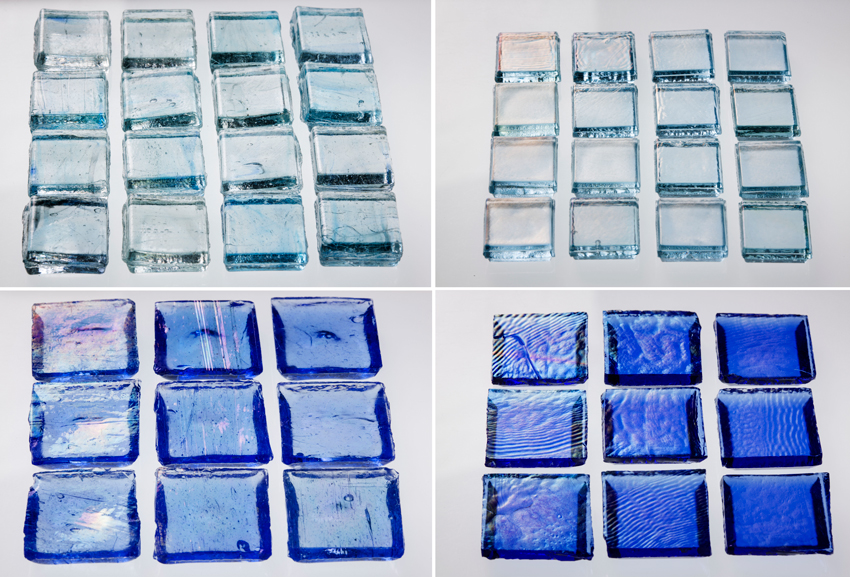Artisanry, Architecture, and North American Glass Tile
The cast products tend to be very durable, and some manufacturers recommend the tiles for higher-impact uses, such as light commercial flooring, as well as specialty environments, including outdoor and submerged water installations, such as swimming pools and water features. In this way, glass tile is available for almost any architectural setting, allowing continuity of finish from wall to floor, from indoors to outdoors, and from dry to wet area applications.
There are two ways to transform a molten product into desired glass tile shapes: hand casting or machine rolling into a mold. The two methods are distinguished not only by production needs but also by quality of the final product. Well-maintained machinery is essential for quality control and consistency. Some high-volume producers may allow for inconsistencies and certain kinds of defects that occur in machine-rolled glass tile, in particular voids left as the molten glass is cooled and rolled. These voids and seeds (impurities) typically cannot be controlled, and they affect the appearance and optics of the resulting tiles. Rollers may also leave striations and other defects on the backs of the tiles, including voids and dimples. These roller defects can lead to difficulty removing grout from the tiles when mounted and installed, also affecting appearance. Also challenging are possible installation issues with thinset not fully bonding to the back of the tiles.

Photo courtesy of Oceanside Glasstile/Chipper Hatter
Some high-volume producers suffer inconsistencies and defects in machine-rolled glass tile (shown left), such as voids and seeds (impurities) that affect the appearance, optics, and installation success.
Hand-cast tile, when properly executed, provides for limited defects and high levels of quality control. The hand-cast products are marked by pure colors and a silky/consistent finish to the tile pieces. Molten glass is hand-ladled into the molds and observed to ensure a consistent thickness. Unique pieces of multiple sizes can be fashioned in this handcrafted process.
While one can ask glass tile makers about their processes, some architects with experience in sourcing glass tile recommend visiting the production facilities to review capabilities and product quality. At a minimum, says Joshua B. Zinder, AIA, NCARB, LEED AP BD C, founder and principal of the integrated architecture and interior design firm JZA D in Princeton, N.J., ask the manufacturers if their glass tiles are intended and suitable for a particular project application. “You could request a video or images of how a product is made, which is important for the cold processes,” he explains. “We also look at their working conditions and discuss their environmental outlook.” Participation with key industry groups like the TCNA or ANSI will help determine if their products conform to key industry standards.
For hot-process products, including hand cast and rolled, most manufacturers are able to share test results and charts. If not, architects may lack basic performance data needed to review application suitability. Similarly, Zinder notes that some claims of recycled content should be substantiated and documented. “Glass tile can be made with recycled bottle glass or other types of postconsumer and postindustrial recycled glass material,” says the architect, who designs high-end hospitality, residential, and commercial architecture, among others. “Asking for details helps, such as how the salvaged glass is obtained and sorted.” Some manufacturers access recyclable glass waste from curbside recycling programs.
Adherence to certain production standards and reporting criteria may be needed to ensure the sourced tile counts toward LEED certification.









